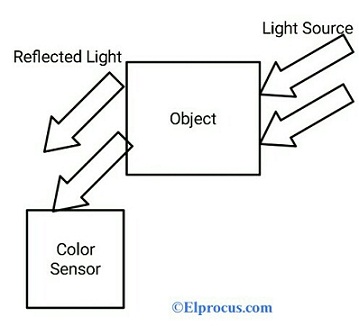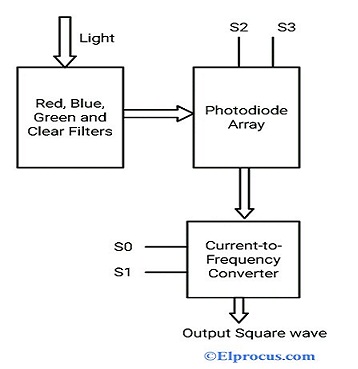In electronics, sensors are the devices or modules or detectors or subsystems used to detect and respond to electrical and optical signals. Sensors can covert physical quantities like temperature, humidity, speed, etc into an electrical signal and send the information to the other electronic devices like the processor. Sensors are classified into various types to measure temperature, capacitance, heat, resistance, etc. They are a temperature sensor, proximity sensor, accelerometer, touch sensor, color sensor, pressure sensor, light sensor, IR sensor, ultrasonic sensor, humidity sensor, and many more. This article describes completely the color sensor.
What is the Color Sensor?
Definition: These sensors are the photoelectric devices that can emit light and detect the color of reflected light from an object. These sensors can detect the intensity of light reflected from an object and differentiates the primary colors like red, blue, and green. These are also called as color detectors.
Colors sensors can illuminate the object with broad wavelength, light ratio, and determine the light intensity of primary colors (red, blue, green, and white). The ratio of intensity light determines the amount of light reflected and absorbed by the object.
Color Sensor Diagram
The circuit of the color sensor contains sensitive filters, sensor arrays, LED’S, target surfaces, and receiver. When the bright red light is illuminated on the object’s surface, the same red light is reflected and blue light is absorbed. This reflection and absorption are determined by the filters used in these sensors.

Color Sensor
Color Sensor Working Principle
As we know that colors are the most important attributes to recognize and evaluate the properties of an object or material. So, these sensors are the detectors used to detect the color of an object when subjected to light and also rejects the unwanted UV light and infrared light. These sensors reflected light and absorbed light in the RGB scale with different wavelengths.
Generally, sensors on the principle of diffuse technology. These are employed in electronics, optics and, software technology to sense the wide range of colors. When white light is illuminated on the target, then the sensor is activated with 3 filters, which have 3 different wavelengths and determines the color of the target with respect to the RGB scale.

Color Sensor Working
In the case of fiber optics, color sensors work on the principle of total internal reflection. The amount of light transmitted and reflected from the targeted object depends on the optical glass fibers. When the white light is illuminated on the targeted object via optical fiber, this sensor detects the reflected light from the object via optical fiber and represented in the long, short, and medium wavelengths. The distance between the two colors is the distance within the color space.
For example, the TCS3200 color sensor uses three filters for three colors to analyze the color reflected by the object. Another filter is for clear, which means no filter. The type of filter (red filter, green filter, blue filter, and no filter) is selected based on the photodiode pins S2 and S3 as shown in the figure. This sensor gives the output square wave with a 50% duty cycle. The converter is used to transform the light intensity and reflected color into frequency.
The frequency of the output is directly proportional to the light intensity and depends on the pins current to frequency converter pins S0 and S1 i.e, high/low. From the obtained output, we can control the frequency of the light for 100%, 20%, and 2%. This output square can be given to a microcontroller directly.
Features
Color sensor features are listed below.
- Accuracy
- Environmental condition
- Wavelength range
- Calibration
- Resolution
- Cost
- Repeatability
- Frequency
The features of color sensor TCS3200 are given below.
- It is a TAOS RGB sensor chip with 4 led’s for 4 filters ( red, blue, green, and clear).
- 8-pin SOIC surface-mount package.
- The operating voltage is 3-5 VDC with PCB size 2.4×2.8 cm.
- A sensor is placed on the surface of the targeted object displays the color on a serial monitor
- Single-supply operating voltage is 2.7V to 5.5V.
- Converts received light to the frequency with high resolution.
- The output gives the programmable color and full-scale frequency.
- Power down factor
- Communication directly to the microcontroller
- Supporting LED light lamp control.
- Used as both color detector and color identifier
- Configuration of wavelengths near-infrared light-750nm to 2500nm and far-infrared – 6 to 15 wavelength range.
Examples
When light is illuminated on the surface of an object, some amount of light will be reflected and others will be absorbed depending on the object characteristics. Here this sensor detects the reflected light and light intensity. Some of the examples of color sensors are Arduino color sensor With TCS3200, color sensor TCS3200, AS73211, TCS3400, TCS34715, TCS34727, ColorPAL sensor, SEN-11195, Lego Mindstorms EV3, and many more.
Industrial color sensors come with a white light transmitter and separate receivers for R G and B. These are 3 filters for red, green, and Blue with wavelengths 580nm, 540nm, and 450nm respectively.
The most widely used color sensor is the Arduino color sensor with TCS3200 in micro-controllers.
When any of the photodiodes in an array is activated, the pulse is of the Arduino oscillator is activated, which is connected to the color sensor output. The frequency of the output signal is calculated and the same process is repeated for the remaining 3 diodes for 3 colors R, G, and B. The output frequency is displayed in the serial terminal identifies the color of reflected light from the surface with the help of corresponding LED.
Applications
The applications of the color sensors include the following.
- Grading of colored products determines coded marks, detects the data codes on a package
- Color detection and color identification
- Used in image processing, and digital signal processing and object identification
- Used in true color Recognition
- Distinguishes different shades of colors.
- Textile industries, automotive industries, the food industry, printing industries, the pharmaceutical industry, etc.sed in quality control in visual inspection tools – monitor the color changes
- Process controlling, production and quality assurance
- Controls, stores and evaluates the visible colors.
- Spectral sensing for color measurement
- Detection of the environment.
Know more about Digital Signal Processing MCQs.
Know more about Resistor Color Code.
Thus, this is all about the color sensor – definition, diagram, working principle, features, examples, and applications. Here is a question for you ” What are the advantages of the Arduino color sensor?”